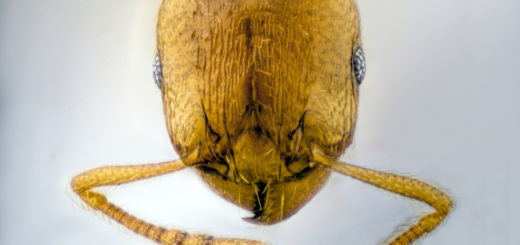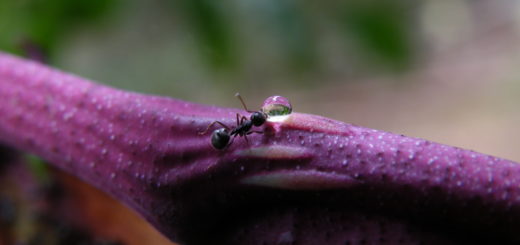How do ants forage for food? Insights from red ants and Western carpenter ants
Ants obtain many of their essential nutrients from food, including essential amino acids that they cannot produce and must acquire from their diet. However, how ants forage for food in order to meet their nutritional needs is still an obscure topic. In the recent article “Contrasting effects of amino acid types on foraging behaviour, colony growth, and worker mortality in red ants and carpenter ants” in Myrmecological News, Reynard and colleagues employ choice experiments to investigate the foraging behaviour of the red ant Myrmica rubra and the Western carpenter ant Camponotus modoc, along with its impact on colony growth, brood production, and worker longevity. Here, Enikő Csata provides commentary on this recent study and its importance in the fields of insect nutrition and behaviour.

Edited by Beatriz Portinha and Salvo Brunetti


Ants are busy foragers, constantly collecting food to meet the needs of their colony, including the development of their larvae. Amino acids, the building blocks of proteins, are among the essential nutrients ants gather. These amino acids come in two types: essential amino acids (EAAs), which ants cannot produce themselves and must obtain from their food, and non-essential amino acids (non-EAAs), which they can make on their own. Interestingly, some of the essential amino acids can even be toxic to ants if they aren’t carefully balanced in their diet. The question of whether ants actively seek out these crucial nutrients, especially the essential ones, and how they impact the growth of the colony is still not fully understood. Renyard and colleagues addressed these questions in their article, “Contrasting effects of amino acid types on foraging behaviour, colony growth, and worker mortality in red ants and carpenter ants.” Through a series of experiments, they explored how different amino acid affect key aspects of ant colony dynamics, such as foraging behavior, brood production, and worker mortality. This study underscores the complexity of ants’ nutritional requirements and offers valuable insights into the role of amino acids in regulating colony performance.
The research investigates two ant species, the red ants Myrmica rubra and the Western carpenter ants Camponotus modoc, both of which exhibit differing preferences for macronutrients — M. rubra favors sucrose, while C. modoc tends to forage for nitrogenous urea and essential amino acids (EAAs).

The authors present compelling evidence that both species preferentially forage for EAAs over non-EAAs, a finding that aligns with previous research on ants, including studies on the Argentine ant Linepithema humile and the white-footed ant Technomyrmex albipes. This preference for EAAs is thought to be driven by the greater nutritional value these amino acids provide, especially given their essential role in protein synthesis and overall growth. Interestingly, however, red ants showed a slightly stronger preference for a blend of both EAAs and non-EAAs, suggesting that the combination of these amino acids might enhance the overall “appeal” of the nutrient source. In contrast,Western carpenter ants consumed both EAAs and mixed blends of EAAs and non-EAAs with similar intensity. These differences in feeding preferences may be explained by the ants’ divergent ecological roles and nutritional requirements, as well as their distinct foraging behaviors.

One of the most intriguing aspects of the study is the finding that M. rubra colonies provisioned with EAAs, as opposed to non-EAAs, did not exhibit greater brood production, contrary to what was initially hypothesized. The researchers speculate that while EAAs are essential for larval development, the overall colony growth might also rely on non-EAAs, or their presence in the diet may simply not be sufficient to promote a noticeable difference in brood production. This result speaks to the intricate balance of nutrients required for optimal colony health and the possibility that non-EAAs, while not essential for protein synthesis, may play other roles in supporting colony function.
Perhaps the most striking discovery of the study is the negative impact that feeding on EAAs had on worker mortality. Red ant workers that consumed sucrose and EAAs had a significantly shorter lifespan compared to those fed sucrose combined with non-EAAs, when in isolation, where larvae were not available to be fed EEAs. This result underscores the potential toxicity of specific EAAs, such as methionine, threonine, and phenylalanine, which have previously been linked to shorter lifespans in other ant species. The toxic effects of EAAs, especially when consumed in isolation, suggest that ants may face trade-offs between acquiring essential nutrients and maintaining their overall health. The study contributes to our understanding of how the balance of nutrients in an ant’s diet can directly impact its individual longevity and survival.

This study offers valuable insights into the nutritional ecology of ants, emphasizing the critical role of amino acids in regulating colony performance and health. By shedding light on the complexity of nutritional preferences and metabolic needs across ant species, this research contributes to our understanding of the broader evolutionary and ecological factors shaping ant behavior. It also highlights the challenges ants face in balancing nutrient intake to support immediate survival while ensuring long-term colony success. Furthermore, the findings raise intriguing questions about the biochemical mechanisms behind these effects and the potential consequences of nutrient imbalances in social insect colonies. Renyard et al.‘s work represents a significant contribution to the field of insect nutrition and behavior, providing a foundation for future studies to explore how dietary composition influences colony dynamics and individual worker health.





Recent Comments